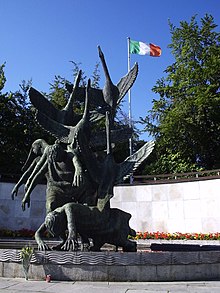Oidheadh Chlainne Lir
Oidheadh Chlainne Lir ( German, The Story of the Children of Lir ) is an Irish legend that is common property in Ireland. She is one of the tragic Irish stories with Aided Chlainne Tuirenn ( German “The Death of the Tuirenn Children” ) and Longas mac nUislenn ( German “The Exile of the Sons of Uislius” ).
content
Lir loves his four children from his first marriage to Aobh so much that their stepmother Aoife goes mad with jealousy. One day she turns the children on Lough Derravaragh into swans , who have to eke out their existence for 900 years on different waters of Ireland. As soon as she has uttered the magic, she is tormented by remorse and gives the swans the gift of unearthly beautiful song.
Lir decreed that no swans should be killed in Ireland. The end of the 900 year period coincides with the arrival of Christianity . The children are regaining their human form, but have aged and die shortly afterwards. In a popular version, they are said to be redeemed when a woman from the south of Ireland marries a man from the north.
effect
The motif of the four swans can be found in paintings, on pub signs and tapestries, as brooches, on postage stamps , as stained glass in the Franciscan monastery of Multyfarnham and the Ulster Museum of Belfast , and as a sculpture in a square in Castlepollard . The most famous representation is the sculpture "Lirs Kinder" ( The Children of Lir ) by Oisín Kelly (1915–1981) in the Garden of Remembrance , the memorial for the Easter Rising of 1916, in Dublin . The three large wind turbines on Rathlin Island are named after the swan boys Aedh , Conn and Fiachra . According to linguistic features, the present narrative dates from the 15th or 16th century, so it is a relatively recent revision of old motifs.
The Irish composer Hamilton Harty created the tone poem The Children of Lir in 1938 .
Web links
- The legend on Mythical Ireland (English)

